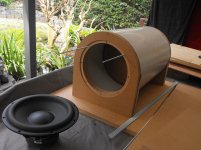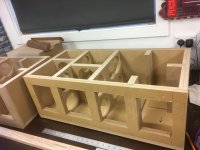Those poor little woofers are having to work soooo hard...
They'd have a much more difficult life trying to produce bass in a dipole system.
Chris
About 20 years ago, I built a sub with 4 12" drivers. No, I don't remember exactly which ones. Regular box, about 6 cu ft. One woofer per side and a table-top. Bracing from side to side. The box is very stable, to the point where my wife was willing to put fragile glass sculpture on top AND she likes it loud....
Time for an update to my original enquiry about the effectiveness of force cancelling woofer techniques. I started with a sub using 400mm plastic drainage pipe. I used 2x12" Peerless XLS drivers for a home theatre sub. This was a trial to evaluate the principle. The 600mm pipe length had a central circular brace but I don't consider it was really necessary. The end baffles were a drop-in fit, glued and screwed to the pipe. 5mm threaded steel rods through the woofer holes have nuts Araldited on one end and a long nut for tightening the other end. The saucer of water balanced on the cylinder with no ripples is amazing verification of the lack of cabinet vibration. Having confirmed the effectiveness, I next implemented force-cancelling in a 4-way active speaker project. The sealed sub-woofer sits below the 3-way sealed enclosure with drivers mounted close to the floor to assist bass output (<100 Hz). Drivers are SB Acoustics SB23MFCL45-8. Threaded 4mm stainless rod are the largest to fit the woofer holes. The results exceed my expectations. I will try and use this method in future projects whenever feasible. The only downside is that side-mounted drivers restrict the possible speaker room positions. Avoid side-walls and nearby furniture.
Attachments
I think we undervalue the vibrating mass aspect of low frequency reproduction, and over focus on the acoustic pressure in the box. I witnessed this by loading a refoamed woofer in an open box (U frame it would be known as these days) and watched everything on or near the speaker rattle and move around while I heard nothing during break-in (25 Hz).
It's cultural: we westerners are always looking for the single significant factor, and second place is for losers. In reality all problems have two parents four grandparents etc.
It's cultural: we westerners are always looking for the single significant factor, and second place is for losers. In reality all problems have two parents four grandparents etc.
I think we undervalue the vibrating mass aspect of low frequency reproduction, and over focus on the acoustic pressure in the box. I witnessed this by loading a refoamed woofer in an open box (U frame it would be known as these days) and watched everything on or near the speaker rattle and move around while I heard nothing during break-in (25 Hz).
It's cultural: we westerners are always looking for the single significant factor, and second place is for losers. In reality all problems have two parents four grandparents etc.
Well put. I know that for me, I'll not likely ever build another non-force-cancelling subwoofer setup again. It's just too much benefit to ignore, and isn't that hard to design in.
My speaker building has evolved over decades. The importance of enclosure rigidity and damping cannot be overemphasised. The force cancelling technique was the last important element to implement after previously taking materials, bracing, constrained-layer-damping to extremes. As the enclosure and driver size increase, force cancelling is a game changer IME. Testing the sub with 15 Hz, doors, windows, furniture in the room were shaking violently. If you have every had a LARGE helicopter go overhead at low altitude, you would have an impression. The saucer of water balanced on the sub did not show even a ripple. Later, it was discovered that the plasterboard (wall board) nails had "popped" at several locations. BTW, the subs are sealed.I think we undervalue the vibrating mass aspect of low frequency reproduction, and over focus on the acoustic pressure in the box. I witnessed this by loading a refoamed woofer in an open box (U frame it would be known as these days) and watched everything on or near the speaker rattle and move around while I heard nothing during break-in (25 Hz).
It's cultural: we westerners are always looking for the single significant factor, and second place is for losers. In reality all problems have two parents four grandparents etc.
Right. Get all the elements working together. I can't imagine a glass of water on top of an OB would be calm when driven to reasonable levels of bass - unless slot loaded.
I started with a sub using 400mm plastic drainage pipe.........
Looks excellent. Where did you source the 400mm plastic drainage pipe in Australia? I wonder if there are any tubes with ID of 445mm as then 18" woofers would fit straight on with no sawdust.
400mm is a standard size. I don't know what is the next size up. I was given the 400mm as a scrap building project item. Wall thickness is approx 8mm, which shows no flex at all under serious drive. A rigid cylinder or sphere cannot pump under uniform internal pressure. The baffles are another matter but should be kept to a minimum as you suggest. I don't know if they can be completely eliminated, since the drivers have to bolt onto something.Where did you source the 400mm plastic drainage pipe in Australia? I wonder if there are any tubes with ID of 445mm as then 18" woofers would fit straight on with no sawdust.
Bon, have you tried by any chance to switch the polarity of one woofer?
I have been doing such experiments and preferred dipolar arrangement to bipolar.
When woofers worked together rather then opposing each other. Sorta like isobaric.
I had data on my page, but took it down.
Maybe worth the try?
I have been doing such experiments and preferred dipolar arrangement to bipolar.
When woofers worked together rather then opposing each other. Sorta like isobaric.
I had data on my page, but took it down.
Maybe worth the try?
Hi Bon
Does your cylindrical sub need some amount of loose fill or batting still, or does it sound fine empty ?
Thanks.
Does your cylindrical sub need some amount of loose fill or batting still, or does it sound fine empty ?
Thanks.
The same stuffing principles as usual for a sealed enclosure. Moderately tightly stuffed with clearance around the drivers. The internal volume of a cylinder still has internal air resonances that will colour the sound by passing through the cone unless damped by fibre-fill.Hi Bon
Does your cylindrical sub need some amount of loose fill or batting still, or does it sound fine empty ?
Thanks.
One time the bass was weak and I had mistakenly wired the drivers out-of-phase. It seems like out-of-phase would get you something akin to an open baffle sub, but with an additional phase difference due to the length of tube. If separate amps were used for each driver with adjustable delay on one, maybe it could be tuned to the immediate environment. I know there are some well-regarded open baffle speakers (Kyron Audio) but tellingly their sub is not open baffle.Bon, have you tried by any chance to switch the polarity of one woofer?
I have been doing such experiments and preferred dipolar arrangement to bipolar.
When woofers worked together rather then opposing each other. Sorta like isobaric.
I had data on my page, but took it down.
Maybe worth the try?
alternative to dual drivers force cancelling?
what if you just fixed the box to a solid wall, i.e. with a bracket/batten etc at the top and bottom of the box?
what if you just fixed the box to a solid wall, i.e. with a bracket/batten etc at the top and bottom of the box?
On second thoughts this would negate the opposed forces exactly cancelling. In fact wiring the woofers out of phase doubles the enclosure reaction forces. A bad idea IMO.If separate amps were used for each driver with adjustable delay on one, maybe it could be tuned to the immediate environment.
Interesting concept, Bon, drainage pipe. Ready made speaker cabinet with lots of advantages. How did you handle the cabling inside and into the 400mm project? Came through the wooden end piece at one end? What glue did you use for the baffles?
Were you able to do any kind of measurements?
Thanks
Derek
Were you able to do any kind of measurements?
Thanks
Derek
I used a small rectangular plastic terminal plate on the underside of the cylinder. Cut the hole to close fit with a jigsaw. A thick bead of glazing silicone and the terminal plate tightened down with screws until silicone oozed but not enough to distort the plate. Allowed to dry 24 hours and tested for leaks. The end baffles also glued up with silicone. It is a 2 layer laminate, with the inner layer a circle that drops snugly into the pipe. A generous bead of silicone around the circle prior to fitting. The silicone must ooze and be smoothed the inside/outside seams with a finger. The outer layer of the baffle is originally slightly over size for the pipe but trimmed flush around the semi-circular part with a router bearing trim bit. The tension rods and silicone hold the baffles solid to the pipe.How did you handle the cabling inside and into the 400mm project? Came through the wooden end piece at one end? What glue did you use for the baffles?
Were you able to do any kind of measurements?
Thanks
Derek
I do have a 3-axis accelerometer that I must use someday.
400mm is a standard size. I don't know what is the next size up. I was given the 400mm as a scrap building project item.
Thanks for the info. You scored getting the 400mm pipe. The new price of such large diameter pipe in 6meter stock lengths is high.
Wall thickness is approx 8mm, which shows no flex at all under serious drive.
Excellent. For extremists wall thickness can be over 28mm!
The baffles are another matter but should be kept to a minimum as you suggest. I don't know if they can be completely eliminated, since the drivers have to bolt onto something.
I wonder if the end baffles could be eliminated by lucky matching of pipe to driver e.g.
1. matching the pipe ID with the driver cut out so the driver neatly slides in the pipe and fixing as usual with screws into thick pipe side walls
2. using your driver-driver threaded rods system that just fits inside the pipe, with the driver flange butting the pipe
- Home
- Loudspeakers
- Subwoofers
- Force cancellation woofers



